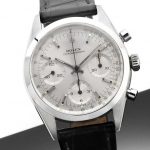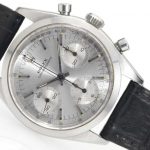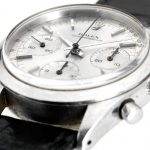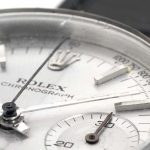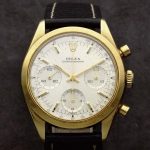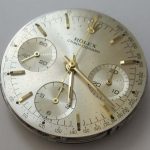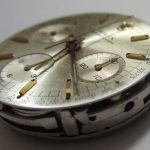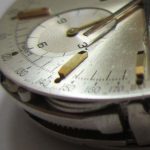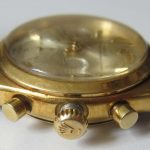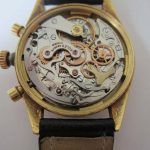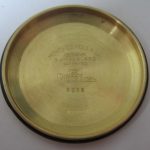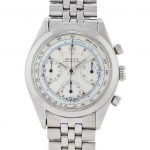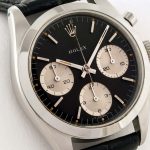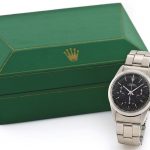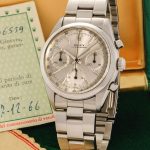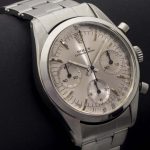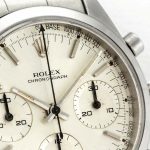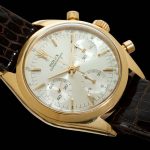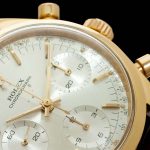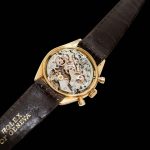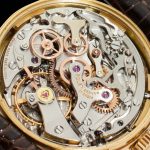ZOOM ON: Rolex “Pre-Daytona” Ref. 6238[:en]ZOOM ON: Rolex “Pre-Daytona” Ref. 6238
IL PONTE PERFETTO. IL ROLEX “PRE-DAYTONA” REFERENZA 6238 RAPPRESENTA LA TRANSIZIONE TRA I CRONOGRAFI ROLEX ANNI 50 (NO CASSA OYSTER) E IL DAYTONA REFERENZA 6239 LANCIATO NEL 1963.
Icona assoluta dell’azienda di Bienne, il Daytona è il protagonista indiscusso al polso e nei desideri degli appassionati. Ma, in fondo, è molto di più di un orologio sportivo di grande fascino. Ha una storia lunga e complessa, contraddistinta da una continua evoluzione fino al raggiungimento del design perfetto immutato dagli Anni 80 – modifiche di dettaglio a parte.
L’INIZIO DI TUTTO
Si può iniziare a parlare di Daytona dai primi Anni 60. Con una precisione: si parla, infatti, di “Pre Daytona”, modello considerato il precursore del “vero” Daytona e ormai universalmente conosciuto tra i cultori con questa denominazione di comodo. Il riferimento è alla referenza Rolex 6238, che subentrò alla referenza 6234 (prodotta a partire dal 1946) che fu in produzione dal 1962 al 1967. Il “soprannome” Pre Daytona gli fu dato dai collezionisti a posteriori.
LA CASSA
Esternamente “il 6238” si presenta con cassa Oyster da 36 mm di diametro, corona Oyster Twinlock serie 600 zigrinata con logo Rolex in rilievo e pulsanti a pompa.
Proposto in acciaio inox, oro 14kt e oro 18kt, è l’ultimo modello con scala tachimetrica stampata sul quadrante e lunetta liscia. Le versioni declinate nel biondo metallo furono prodotte per un periodo di tempo limitato sicché oggi, rispetto all’acciaio, sono più rare da individuare.
IL MOVIMENTO
Da un punto di vista produttivo, fino al 1987 tutti i movimenti montati sui cronografi Rolex derivano dal calibro base Valjoux 72 A (nella produzione aziendale si incontrano, quindi, i calibri 72 B, 722 e 722-1). Il movimento veniva personalizzato da Rolex con alcune modifiche strutturali quali, ad esempio, l’introduzione del bilanciere con regolazione a microstella e l’impiego di due alloggi orizzontali per fissare il movimento alla cassa.
Al suo interno, quindi, il Pre-Daytona fu equipaggiato, fino al 1965 circa, con il calibro manuale Valjoux 72 B e dal 1965 al 1967 circa, con il calibro 722 (in realtà una semplice ridenominazione dello stesso 72 B). L’indicazione del movimento, su questo modello, era sovente incisa sulla platina, sotto il ponte del bilanciere.
QUADRANTE
Il quadrante, protetto da vetro bombato Tropic 21 mostra, oltre alla scala tachimetrica stampata che ne segue la curvatura, la dicitura Rolex Chronograph a ore 12, i contatori cronografici a cerchi concentrici in rilievo leggermente incassati (30 minuti crono al 3, 12 ore crono al 6 e secondi continui al 9) e, a ore 6, l’indicazione T-Swiss-T dove la lettera T sta per trizio. Ciò giustifica la mancanza di tale lettera su alcuni esemplari di Pre Daytona che utilizzavano paste a base di stronzio o radio fino a quando, a partire dal 1998, Rolex ha iniziato a utilizzare la Luminova.
Nella preserie (numeri di matricola fino a 800.000 circa) furono montati i quadranti dalla grafica simile alle referenze 6034 e 6234 ed altri quadranti di evoluzione, con o senza scala graduata e dicitura Oyster e con indici e lancette a foglia verniciate in bianco sui quadranti neri e in metallo brunito sui quadranti in colore argento. La serie definitiva – contraddistinta da numerazione di serie con cifre intorno a 1.000.000 – venne prodotta sia con quadrante argento (chiaro o scuro con sfumatura radiale), sia nero. E’, infine, piuttosto rara la versione con scala telemetrica e pulsometrica.
FONDELLO
Il fondello è lucido esternamente mentre satinato nella parte interna dove è riportato inciso il marchio, il brevetto Rolex, il materiale con il quale è stato realizzata la cassa e il numero della referenza. Capita di trovare anche la sigla C.R.S. (Charles Reneé Spielman), all’epoca uno dei principali produttori di fondelli per conto di Rolex e l’unico autorizzato a porvi il proprio nome. E’ da evidenziare che ci si può imbattere in fondelli recanti un numero di referenza differente da quello inciso tra le anse superiori della cassa. Il fondello con referenza diversa, di solito 6239, la si può trovare sugli esemplari fine serie.
Il bracciale è di tipo Oyster rivettato con maglie fisse o estensibili. La sua impermeabilità non è stata dichiarata.
PRODUZIONE
E’ interessante notare come, nell’ambito di tutta la storia dell’azienda, il Pre-Daytona ref. 6238 sia uno dei pochi modelli di cui si conosca, naturalmente sempre con un certo grado di incertezza, un dato piuttosto preciso sulla produzione complessiva. Tra il 1964 e il ’67 ne furono realizzati circa 3.600 esemplari in acciaio e circa 400 in oro 14kt e 18kt.
Fonte: www.mazzariolstefanolibrary.com
Photo credit: www.bonhams.com, www.antiquorum.swiss[:en]
THE PERFECT BRIDGE. THE ROLEX “PRE-DAYTONA” REFERENCE 6238 REPRESENTS THE TRANSITION BETWEEN THE ROLEX CHRONOGRAPHS OF THE ’50S (NO OYSTER CASE) AND THE DAYTONA REF. 6239 LAUNCHED IN 1963.
Absolute icon from the company in Bienne, the Daytona is the undisputed protagonist on the wrist and in the desires of watch lovers. However, it is more than a fascinating sports watch. It has a long and complex history, characterized by a continuous evolution until the perfect design unchanged since the ‘80s – detail changes apart.
THE START OF EVERYTHING
You can start talking about the Daytona since the early ‘60s. With a precision: it is, in fact, a “Pre Daytona”, a model considered the precursor of the “true” Daytona and now universally known among the watch lovers with that suitable designation. The reference is the Rolex 6238 which replaced the reference 6234 (produced since 1946), produced since 1962 to 1967. The collectors later gave it the “nickname” Pre Daytona.
THE CASE
Externally the “6238” has a Oyster case, 36 mm diameter, Oyster Twinlock crown series 600 knurled with the Rolex logo embossed and push-buttons.
It is made of stainless steel, 14kt gold and 18kt gold, it is the latest model with a tachometric scale printed on the dial and smooth bezel. The versions made of golden metal were produced for a limited period of time, so today, compared with that made of steel, they are harder to find.
THE MOVEMENT
From a productive point of view, until 1987 all the movements mounted on the Rolex chronographs derive from the Valjoux 72 A base calibre (therefore, within the company production there are the 72 B, 722 and 722-1 calibres). The movement was customized by Rolex with some structural changes such as, for example, the introduction of the balance with microstella system and the use of two horizontal housings to secure the case movement.
Therefore, inside the Pre-Daytona was equipped, until about 1965, with the manual Valjoux 72 B calibre and since 1965 to about 1967, with the calibre 722 (actually a simple renaming of the 72 B itself). The movement indication on that model was often engraved on the platina, under the balance bridge.
THE DIAL
The dial, protected by a curved glass Tropic 21, shows, in addition to the tachometric scale printed following the curvature, the Rolex Chronograph writing at 12 o’clock, the chronograph counters with slightly centred spotlighted concentric circles (30 minutes chrono at 3 o’clock, 12 hours chrono at 6 o’clock and continuous seconds at 9 o’clock) and at 6 o’clock the T-Swiss-T writing, where T letter means tritium. That justifies the lack of such a letter on some Pre Daytona specimens using strontium or radio paste until, since 1998, Rolex began using the Luminova.
In the pre-series (serial numbers up to about 800.000), it was mounted the dials with a graphics similar to the references 6034 and 6234 and other evolution dials, with or without the graduated scale and the Oyster writing and with indexes and leaf hands painted white on the black dials and burnished metal on the silver coloured dials. The definitive series – marked by serial numbering with figures about 1.000.000 – was produced either with silver dial (light or dark with radial nuances) and black. Finally, the version with the telemetric and pulsometric scale is rather rare.
THE BACK COVER
The back cover is glossy externally and satin internally where it is engraved the logo, the Rolex patent, the case material and the reference number. It is also possible to find the C.R.S. acronym (Charles Reneé Spielman), at the time one of the leading back cover manufacturers on behalf of Rolex and the only one authorized to name it. It should be pointed out that back covers with a reference number different from the one engraved between the upper case wings can be found. The back cover with a different reference, usually 6239, can be found on the close-out sale specimens.
The bracelet is Oyster type riveted with fixed or extensible meshes. Its waterproofness has not been declared.
THE PRODUCTION
It is interesting to note that, throughout the company history, the Pre-Daytona ref. 6238 is one of the few models of which you know, of course with a certain degree of uncertainty, a fairly accurate data on the overall production. Between 1964 and 1967 it was produced about 3.600 steel specimens and about 400 golden 14kt and 18kt specimens.
Fonte: www.mazzariolstefanolibrary.com
Photo credit: www.bonhams.com, www.antiquorum.swiss

